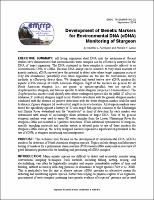Please use this identifier to cite or link to this item:
https://hdl.handle.net/11681/3941Full metadata record
| DC Field | Value | Language |
|---|---|---|
| dc.contributor.author | Farrington, Heather L. | en_US |
| dc.contributor.author | Lance, Richard F., 1967- | en_US |
| dc.creator | North Carolina State Museum of Natural Sciences | en_US |
| dc.creator | Environmental Laboratory (U.S.) | en_US |
| dc.creator | Ecosystem Management and Restoration Research Program (U.S.) | en_US |
| dc.date.accessioned | 2016-03-16T16:15:56Z | en_US |
| dc.date.available | 2016-03-16T16:15:56Z | en_US |
| dc.date.issued | 2014-09 | en_US |
| dc.identifier.govdoc | ERDC TN-EMRRP-RQ-02 | en_US |
| dc.identifier.uri | http://hdl.handle.net/11681/3941 | en_US |
| dc.description | Technical Note | en_US |
| dc.description.abstract | All living organisms shed DNA into the environment. Recent studies have demonstrated that environmental water samples can be effectively assayed for the DNA of target organisms. The DNA contained in these samples is commonly referred to as environmental DNA or eDNA. Because DNA assays can be sensitive to very small amounts of genetic material, eDNA surveys have the potential to detect sites where target organisms occur at very low abundances, potentially even when organisms are too rare for conventional survey methods to effectively detect them. We designed and tested twelve new eDNA markers for aquatic eDNA surveys of North American sturgeon. Eight of the markers are general for all North American sturgeon (i.e., not genus- or species-specific), two are specific to Scaphirhynchus sturgeon, and two are specific to white sturgeon (Acipenser transmontanus). The Scaphirhynchus marker could identify sites where endangered species like the pallid (S. albus) or Alabama (S. suttkusi) sturgeon might occur. Positive detections with the general sturgeon marker combined with the absence of positive detections with the white sturgeon marker could be used to discern if green sturgeon (A. medirostris) might occur at a location. All sturgeon markers were tested for specificity against a battery of 32 non-target fish species common to the Mississippi and Illinois River watersheds and the “sensitivity” or limit of detection for each marker was determined with assays of increasingly dilute solutions of target DNA. Four of the general sturgeon markers were used to assay 88 water samples from the Lower Mississippi River for sturgeon eDNA and resulted in 3 positive detections. While additional optimization of sturgeon-specific sampling protocols and marker assays is advised prior to use of these markers for sturgeon eDNA surveys, the newly designed markers represent a significant step forward in the use of eDNA in sturgeon monitoring and management. | en_US |
| dc.description.sponsorship | Ecosystem Management and Restoration Research Program (U.S.) | en_US |
| dc.format.extent | 12 pages/2.44 MBs | en_US |
| dc.format.medium | PDF/A | en_US |
| dc.language.iso | en_US | en_US |
| dc.publisher | Engineer Research and Development Center (U.S.) | en_US |
| dc.relation | http://acwc.sdp.sirsi.net/client/en_US/search/asset/1036340 | en_US |
| dc.relation.ispartofseries | Technical Note (Ecosystem Management and Restoration Research Program (U.S.)) ; no. ERDC TN-EMRRP-RQ-02 | en_US |
| dc.rights | Approved for public release; distribution is unlimited | en_US |
| dc.source | This Digital Resource was created in Microsoft Word and Adobe Acrobat | en_US |
| dc.subject | DNA | en_US |
| dc.subject | Environmental DNA | en_US |
| dc.subject | eDNA | en_US |
| dc.subject | Sturgeon | en_US |
| dc.subject | Environmental management | en_US |
| dc.subject | Ecosystem management | en_US |
| dc.subject | Genetic markers | en_US |
| dc.subject | Ecosystem Management and Restoration Research Program (U.S.) | en_US |
| dc.title | Development of genetic markers for environmental DNA (eDNA) monitoring of Sturgeon | en_US |
| dc.type | Report | en_US |
| Appears in Collections: | Technical Note | |
Files in This Item:
| File | Description | Size | Format | |
|---|---|---|---|---|
| ERDC-TN-EMRRP-RQ-02.pdf | 2.5 MB | Adobe PDF |  View/Open |